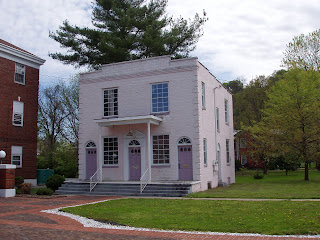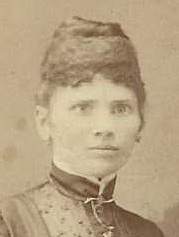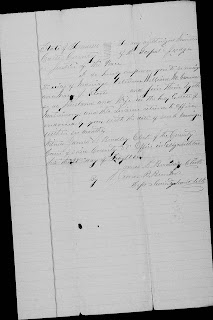 |
| Home of Daniel Stover with Robert Nave in 2012 |
Daniel
Stover was born in Pennsylvania on April 10, 1776 – the same year that the
American colonies declared independence from Britain.[i]
He was the son of Christian Stover and Sarah Limbaugh. “When the first census
was taken in 1790 Daniel was recorded only as a tic mark in the column headed
“Free white males under the age of 16. Daniel was 14 at the time. This was the
Dauphin, Pennsylvania census.[ii]
At the age of 18 he married Phoebe Ward on September 7, 1794 and the couple
settled in Carter County, Tennessee. Phoebe, born on August 12, 1772, was the
sixth of seven daughters of William Ward and Sarah Bryant.
Daniel
and Phoebe had eleven children. The eldest William Ward Stover, born in 1795,
was my third great grandfather. William was followed by Mary Lincoln 1796-1860,
Jemima 1798-1876, Isaac Lincoln 1801 – unknown, Thurzy 1804-1847, Susannah 1806
- , Lavisa 1808- , Solomon Hendrix 1812-1889, Delilah 1814-1902, Sarah 1816 - ,
and Daniel Stover Jr. 1820- 1838 (not to be confused with Col. Daniel Stover
who was the brother of my 2nd great grandfather David Lincoln
Stover.)[iii]
Like his father, Daniel was involved in community, civic and church affairs throughout his lifetime so records from those various sources tell us quite a bit about who he was and the life he lived. A church record tells us that Daniel was already a leader in his Baptist Church as early as 1794. He was a member of the Sinking Creek Baptist Church. The name refers to the fact that a nearby a creek ended by seeking into the ground. Sinking Creek broke off from Buffalo Ridge Church and was one of the most influential Baptist churches in the area. According to Frank Merritt’s Early History of Carter County, two preachers, Jonathan Mulkey and Reese Bayless, and three laymen, Solomon Hendrix, Alfred Carr and Daniel Stover were the most outstanding members in the history of the church. Daniel was appointed clerk and deacon of the Sinking Creek Baptist Church at the age of 27 in 1803 and held the position at least until 1820.
 |
| Patriot monument in Elizabethton |
Mrs. Nancy Tipton
Johnson, said that “as a girl she often went to Daniel Stover's home to
preaching, and at times they would often build arbors to preach under. There is
no doubt that the Baptists were pioneers here and were hunting a place where
they could worship without molestation.” She went on to say, “Daniel Stover’s
home was an assembling place for the Baptist ministers. He possessed a bible,
and there were but few Bibles in those days, so the Baptist clans would gather
to hear him read the Word.”[iv]
Daniel appeared on the Carter County tax list as early as 1796. The book Historical Reminiscences of Carter County notes that he was the seventh person named as settling in Siam Valley of Elizabethton in Carter County. On January 8, 1807 he was appointed administrator of his father-in-law’s estate.
Road Projects
In 1805
he was charged with making and laying off a road in his community. This was a
common responsibility of land owners during that era. In June of 1820 the court
appointed Daniel to “view, mark and lay off a road from A.N. Carter’s ironworks
on Stoney Creek by Rubin Brook’s and Christian Carriger’s mill fence crossing
the Watauga at Nave’s Ford. From there the road was to go by Henry Bowers and
Daniel’s own fence, whichever was nearer and the best way to intersect the
public road near William B. Carter’s on the Doe River.” He was also told to
make a report at the next court.
Two
years later Daniel was again ordered to “lay off a road from Alfred M. Carter’s
forge to Scott & Johnston’s forge. That is to say, that part of the road
running through the plantation of Abraham Nave – the divining line between
Daniel’s and Nave’s land, to intersect with the old road.”
Daniel was involved in another road project in 1824 that involved figuring out the best route from Caleb Smith’s and across the mountain to Zachariah Campbell’s. The recommended route would “avoid the many bad fords across the Doe River and also save the expenditure of the money to be given to William Lindsey Esq. to make the road around the Dripping Rock Ford on said Doe River.” This record went on to propose “the drawing of a lottery to raise money to assist in opening the public road from Elizabethton to North Carolina.”
 |
| Historic courthouse in Elizabethton |
Era
of Property Acquisitions
Daniel
and Phoebe purchased fifty acres, adjacent to land owned by Leonard Bowers, from
Abraham Nave for $300. That was on August 10, 1807. The deed stipulated that
the purchase included “all the woods, ways, water, water ways, profits,
commodities and appurtenances and the rivers in and riverines and rents. “[v]
In 2022, historian Robert Nave told me
that Daniel Stover’s home was probably built about 1809. He thought it was
possible that Abraham Nave built the original log home that was later boarded
over. Originally it had a limestone chimney that was removed in the 1960s when
Dale Hamilton owned the property.
In 1808
or 1809 Daniel purchased a two-year old Bay Mare from John Daniel for $16.25,
and on March 23, 1810 he received a gift of four-year old Ruth – a slave from
Isaac Lincoln.[vi]
After living as a renter for several years Daniel purchased the home he was living on and a 149-acre property for $1000 from Isaac Lincoln. The date of the deed was February 18, 1812. This home was still and in good condition when I visited Tennessee in 2012.
 |
| A bad photo of a monument to Daniel's service during the war of 1812 from Mr. Nave |
Military
and Civic Service
Daniel
was a sergeant during the War of 1812 when he was 36. He served in Colonel Wear’s
1st Regiment East Tennessee Volunteers as a substitute for Thomas
McQueen. It was not uncommon for men to pay for a substitute to serve in their
place as Daniel did.
From his
late twenties to early fifties Daniel served on several juries which was a very
common practice at that time. The earliest such record I found was dated 1804. While
today many of us complain when we receive a jury summons, at that time all land-owning
men – not women – were expected to sit on juries routinely. This was true for
many, if not all, of our male ancestors. I found records from ten different
cases he was involved with during 1822. In one case a Robert Blevins charged
Daniel with something not explained in the record. Daniel was found responsible
and was fined $2.00. In a separate dispute with John Orland, Daniel was charged
$10. A third case on the same day between Daniel and James I. Tipton favored
Daniel but the fine was only $0.50.
Daniel
was a member of the jury for a case against John Arnold on May 14, 1822. The
defendant was found guilty and was “taken to the whipping post to receive three
lashes on his bare back well laid on after half past six in the evening.”
The 1830 census is the first that listed Daniel by name but little additional information was provided other than tic marks indicating that there were 3 white males and 4 white females in his household that would have been his wife Phoebe and their children.
 |
| Marriage record for Daniel and Antoinette Williams |
Daniel’s
wife Phoebe died on August 8, 1839 at the age of 66. She is buried in the
Nave-Hess Cemetery also known as the Stover Cemetery on Wilbur Dam Road in
Elizabethton, Tennessee. Slightly less than a year later Daniel married
Antoinette Williams on July 19, 1849. Antoinette was the daughter of Elisha Williams. She was born in Virginia on
August 10, 1810 so was considerably younger than Daniel – 34 years younger.
Then on February 11, 1857 she married Elijah D. Hardin whom she divorced
sometime before her death.[vii]
Daniel and Antoinette had six children together. They were: Lorina born March 3, 1841, Rhoda July 27, 1842, Samuel January 17, 1844, Eliza Isabella December 5, 1845, Elizabeth April 3, 1847, and Margaret Ann December 21, 1848.[viii] All of these children appeared with Antoinette on the 1850 census for the 9th Civil District of Carter County.
 |
| Antoinette Williams, Daniel's 2nd wife |
The 1840
census was similarly minimal. Daniel was listed with 2 other white males and 2
females. From the slave census taken that same year we know that he owned four
slaves – one male and three females. His son William is listed separately on
the same page.
In 1846 Daniel donated a one-acre lot in Carter County for a school. It was known as the Stover School and served the community for forty years. Daniel was the first school teacher, and he and Matthias Vinhos were trustees.[ix] The site of the school was adjacent to property owned by Daniel and David Bowers. Tice VanHusk, Christian E. Carriger and Daniel S. Bowers, built a log house that served as the school and as a church. When the public school system started, they tore down the log structure and built a frame structure which lasted long enough for Robert Nave to attend school there. According to Robert, “In 1872 a church was built next to the school. That was torn down and replaced by the existing stone church in 1934 or 35. To do so they had to go to court because the land had originally been donated for a school. The court ruled to allow the church to be built, on the basis that there were too many Stover descendants to get permission from all of them.”[x] In 2021 the site was the location of the Siam Baptist Church.
 |
| Siam Baptist Church, 2012 |
Daniel’s Death and Will
Daniel
died on May 24, 1849 in Elizabethton at the age of 73. He is buried with his first
wife Phoebe in the Nave-Hess Cemetery. Robert Nave purchased and had a new
headstone installed at Daniel’s home in Siam. Robert explained that he’d done
so in order to prevent the cemetery from being developed and lost. He also told
me that after Daniel’s death his son Samuel, from his second marriage, had a
moonshine still on Daniel’s property after the Civil War. He said that, “most
people in the area were proud Baptists and found this upsetting because Daniel
had been such a pillar of the church. So, the neighbors harassed Samuel and got
him to move away.” Next the house was owned by John Grindstaff who sold it to
the Harden family, and they sold it to Porter Nave. Porter plowed up the Stover
cemetery in about 1915. Nave said, “there used to be a large cemetery with
several graves.” Now only the headstone for Daniel Stover that Robert installed
remains.[xi]
Mr. Nave said, “the original headstone for Daniel was installed by the
Daughters of 1812 and he believed that the arrangements were made by Mary
Stover, daughter of Solomon Hendrix Stover.” This would have been in about
1940.
In his
will dated May 9, 1849 Daniel left everything to his wife Antoinette and the
children they had together.[xii]
The will made no mention of this children from his marriage to Phoebe. Each of
his daughters were to receive the equivalent of the “value of one horse, one
cow, one breeding sow, one ewe, one bed and bed clothes, and some cupboard
furniture such as plates, dishes etc. as they arrive at age or marry.” He left
his slaves to his wife “in trust” so she could use the proceeds from their work
to support their children. When his son Samuel reached the age of 21, he would
inherit the slaves. Daniel made this stipulation so that, if Antoinette
remarried, her new husband would not get the slaves.
His son
Samuel inherited all the land. That was about 150 acres on the Watauga River
and included the family home, but the home and land was left in trust to
Antoinette until Samuel reached 21 at which time Antoinette was to “surrender
to him (Samuel) the possession of the lands aforesaid and then my said son
Samuel is hereby required to support his mother comfortably during her life.”
Daniel’s
slave Nathen was left to Samuel while Ruth was left to Antoinette and upon Antoinette’s
death Ruth was to be allowed to “live with any one of my children that she
prefers and should it so happen that she becomes a charge, then I require my
son Samuel to support her during her life.” Daniel’s remaining slaves and their
children were to be divided among his daughters.
Daniel appointed Elijah D. Hardin as the executor of his will and he requested that the court not require a security from Hardin. Makes you wonder if Daniel intended for Antoinette to marry Hardin.
 |
| This is the headstone that Robert Nave purchased and had installed by the DAR for Daniel Stover. It is located adjacent to his home. |
[i] A paper listing the descendants of Daniel Stover.
[ii]
1790 Dauphin, PA, NARA Series M637, roll 8 p. 203; image 392 on film 0568148.
[iii]
Family Group Sheet prepared by Robert Nave, Carter, TN.
[iv]
William Montgomery Clemens Editor, Genealogical, Historical and Biographical, The
Lincoln Family Magazine, New York, 1916-17, p. 20
[v] Deed
Book for Carter Co., Images 370-80, pgs. 110-111,
[vi]
Vickey L. “Morrow” Hutchings, Tennessee Deed Books A-B July 1796 – Oct. 1815
Vol. 1, , Carter Co TN Deeds, Image 447 p. 243-44. 23 March 1810.
[vii] Family
Group Sheet prepared by Robert Nave, Carter, TN.
[viii]
Ibid.
[ix]
Mildred Kozsuch, Historical Reminiscences of Carter County, TN Johnson City,
Overmountain Press.
[x]
Told to the author by Robert Nave in 2012.
[xi] A
post by Janice Holzer wrote, “Near by the house were servant quarters and at
one time there were markers on the property to mark the graves of slaves.” Her
source was an article by Rozella Hardin in the Elizabethton Star, 23 July 1995.
[xii]
Will Book 1, p.411-414, Carter, TN.
























